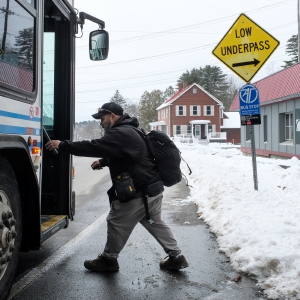Potential logging of public land around Lake Tarleton sparks debate on forest management
| Published: 12-10-2021 6:24 AM |
PIERMONT — Officials overseeing the White Mountain National Forest this week postponed a final decision on a proposal to log approximately 880 acres of national forest land near Lake Tarleton and will reopen public comment.
The decision comes after a group of residents, environmentalists, regular users of the lake and donors who helped bring the forest into public hands had urged the U.S. Forest Service to hold off and scale back any logging near the lake, which is on the border of the Grafton County towns of Piermont and Warren.
On Tuesday, the opponents, known as the Lake Tarleton Coalition, had sent a letter to District Ranger Brooke Brown, with New Hampshire’s congressional delegation copied, requesting that “before making decisions with decades of impact,” the White Mountain National Forest pause the project and reopen public comment in part because the COVID-19 pandemic limited the Forest Service’s ability to engage the public in a region where many do not have access to high-speed internet. They also argue that “the scope of work” near the lake is “incompatible with the spirit of and intent for which this forestland was acquired and transferred to public ownership more than two decades ago.”
Brown emailed the coalition on Thursday, telling them that there will be a second “draft environmental assessment” and a second formal comment period “in early 2022,” before any logging would take place.
The Forest Service had put forward the logging project to meet ecological goals and harvest timber. The White Mountain Forest Service announced the plan in the fall of 2019, including at Selectboard meetings in Warren and Piermont, and an open house in Warren. After the pandemic began, engagement events were online. The official 30-day comment period on the draft environmental assessment closed this summer, but Lynn McAloon, a spokeswoman for the White Mountain Forest Service, said she reads and processes all the comments sent outside of that period.
But when the Forest Service opened the public comment period, Rob Wipfler, who operates Kingswood Camp for Boys on the lake with his brother, was trying to keep 160 boys from 8 to 16 both safe and busy in the middle of the pandemic.
“I’ve never worked so hard in my life,” he said. He never found time to weigh in on the project.
The campers hike through the forests, kayak on the lake and fall in love with the outdoors for life with Lake Tarleton as the backdrop with its “unique wilderness feel,” Wipfler said. He worries that the logging may disrupt the pristine setting that brings them back even after they graduate.
Article continues after...
Yesterday's Most Read Articles
 Upper Valley winter shelters kept dozens warm and dry
Upper Valley winter shelters kept dozens warm and dry
 Former principal of South Royalton School released from prison
Former principal of South Royalton School released from prison
 Owner of Friesian horse facility ordered to pay care costs for seized animals
Owner of Friesian horse facility ordered to pay care costs for seized animals
Residents and tourists alike cherish Lake Tarleton. High in the White Mountains, forested slopes cradle the glassy mountain lake that spans 315 acres. Hemlocks cluster on its rocky banks, circling it in green even in the brown doldrums of early winter. Mount Moosilauke, with its snowy white peak, ascends behind forested mountains rising around the lake.
Every morning, Joyce Tompkins, a Piermont resident and a member of the Lake Tarleton Coalition steering committee, rakes a small beach on the lake that is part of a 48-acre undeveloped state park on the lake’s northern shore. She is president of the Lake Tarleton Association, a group of volunteers who monitor the lake’s water quality and organize a “Lake Host” program to inspect boats for invasive species. Tarleton is free of invasive species that other lake associations wrestle against, and critics of the project argue that logging equipment could bring them into the forest. She and other residents are concerned that logging will undermine the pristine quality of the lake. There would also be cuts near Lake Katherine, a smaller sister lake.
The map of the proposed project shows that stands near the shore of Lake Tarleton, though abiding by shoreland perimeters required by law, are targeted for “group selection” cuts.
“They want to improve the land. For the most part, I think that’s true,” Tompkins said. “We’re concerned about the logging, particularly the clear-cutting. We’re also concerned about the possibility of using herbicides. We don’t want anything like that near our lake.”
Beauty is also at stake for Robin Ascher, an artist who lives by the lake with her husband, Peter.
“It’s iconic,” she said. And that view isn’t just hers. Every summer, she watches other painters set up their easels to paint, and hundreds more simply admire it. The Forest Service conducted studies to minimize impact on the view from two outlooks, but proposed clear-cuts would make “holes” visible from across the lake, she said.
“They have thousands of acres in the White Mountain National Forest. As far as I’m concerned, this is really not necessary,” she said. “Go on the other side of the hill where no one is living and no one is looking.”
But Bret Ryan, who lives in Lyme and owns a residence on the lake, sees things differently. He is not opposed to the logging, which would take place on about 16% of the White Mountain National Forest’s 5,375-acre Lake Tarleton Habitat Management Unit.
“One of the things you do with forests is you manage it,” he said. “You know they’ve been there obviously, but it heals pretty quickly.”
Lake Tarleton may look pristine, but it’s not untouched by humans. As with much of the White Mountains, early settlers flattened the forests for agriculture and grazing. In the early 20th century, large logging companies cut them so intensively that wildfires sparked and cities hundreds of miles downstream felt the consequences in their water quality. (Tarleton’s waters flow into the Connecticut River by way of a brook.) At Lake Tarleton, the last logging was in the 1990s, when a private landowner contracted commercial cuts. But some stands have not been touched for longer.
But for the Forest Service, scientifically informed logging is part of its plans to preserve a healthy ecosystem with a diversity of species. Except in designated “wilderness” zones, the Forest Service logs its lands in 20- to 25-year rotations.
“Most wildlife species use more than one kind of forest age class to meet their life requirements, so our management activities aim to provide this variety,” McAloon said. The “flush of vegetation” — the blackberries, raspberries and wild grasses — that regenerates when trees are cut away offer wildlife food and cover. And birds that nest in mature forests feast on the abundant food in the land regenerating from clear cuts before they migrate south, according to studies in the White Mountain National Forest.
In a draft environmental assessment, the Forest Service described why it believes that the forest needs intervention. Without “open forest conditions,” species like birch and aspen that need abundant sunlight struggle to grow. The Forest Service uses logging to create more “regeneration-age” stands — younger than nine years old — for wildlife habitat. Loggers will also target stands of nonnative trees so native trees can retake land from nonnative Scots pine and Norway spruce. The report emphasizes that loggers will cut “damaged” and “poor-quality” trees while they leave vigorous, healthy trees standing. “Tree mortality resulting from natural causes thus would likely decrease in the near future,” the report asserted.
Logs from low-quality trees still make it to the mills, and targeting weak trees leads to higher-quality timber that helps the local economy, McAloon said. Some revenue from the sales go directly to local towns, while 75% goes to the Forest Service for “forest improvement” and the U.S. Treasury. The logger also gives the town 10% of the total value of the timber.
The report also outlines measures to prevent damage to water quality, which can occur when runoff washes over soil exposed during a logging project as well as the accidental introduction of any invasive species. All logging would be done during the winter months when the ground is frozen and protections such as water bars would limit erosion. All equipment that enters the National Forest is washed and inspected, and the Forest Service inspects gravel and till for invasive species, McAloon said. The draft assessment concluded with a preliminary finding of no significant environmental impact.
But members of the Lake Tarleton Coalition, in interviews last month before Thanksgiving, highlighted the lake’s long history of conservation.
Though there are three homes, a summer camp and seasonal hunting camps on the lake, members of the coalition emphasize that most of the lake is undeveloped. A fashionable, four-story club once looked over the lake, but it is long gone. Residents in the area fought further development and defeated plans for a 5,000-home development in the early 1970s as well as a resort in 1994.
In 2000, conservation-minded nonprofits and individuals raised about $7 million to buy and protect over 5,000 acres around Lake Tarleton in Warren, Piermont and Benton in perpetuity. That included $6 million in money from Washington, but it was also a grassroots effort, with over 600 individuals, local businesses, and foundations contributing $450,000. The land became publicly owned when the White Mountain National Forest acquired the land from the Trust for Public Land 20 years ago.
“We couldn’t allow it to be developed,” said Paul Guyre, a biotech entrepreneur and retired immunologist at the Geisel School of Medicine, who believed there would be no threat of “development, pillage or plundering” in 1999 when he and his wife, Veronica, contributed to protect the lake. And as he sees it, logging undermines that commitment.
Some activists are opposed to any cutting in a public forest.
“It has rewilded, but it has hardly recovered. … To cut off that recovery seems like a crime,” said Zack Porter, the director, and only employee, of Standing Trees, in a Zoom interview. The Montpelier-based coalition formed in fall 2020 to “unfetter” public forests from active management and logging. The group criticizes logging not only at Lake Tarleton, but on all public land. Porter is a member of the Lake Tarleton Coalition’s steering committee.
Porter, who once worked as a Forest Service wilderness ranger in the Pacific Northwest, argues that publicly owned lands should not be logged. With most forests in private hands, where logging cannot so easily be regulated, public forests should be left for nature, he argues.
“Our forests take care of themselves. They don’t need logging to be healthy,” he said. “When we manipulate at this level, it’s extremely unnatural.”
Porter also argued that “old-growth forests” are critical carbon sinks, that they are more resilient to climate change, and that they improve the quality of a watershed. Recent research shows that older trees continue to absorb carbon.
An old-growth forest has many qualities that set them apart from younger forests, according to the Department of Natural Resources. They are often home to rare species and native plants, and they have relatively few invasive species. They carry the legacies of centuries of life: biomass stocked below ground, robust communities of mycorrhizal fungi, and dead trees that serve as habitats, and recent research from the University of Vermont indicates that they have more diverse age groups than previously understood.
But some scientists argue that stepping back is not the way to meet ecological goals in a forest.
“Big and beautiful forests don’t just happen. They are the product of some sort of proactive forest management,” said Matthew Ayres, a forest ecosystems professor at Dartmouth College who works at the Hubbard Brook Experimental Forest in the White Mountains. “We have the impression that if we just don’t touch them, they will take on all the properties that we want forests to have. It doesn’t work that way.”
And younger forests have their advantages too. At Hubbard Brook, there is evidence of a “little more” carbon in the stable mineral soil of older forests, but younger forests absorb more carbon out of the atmosphere: “They’re growing fast. Small trees grow faster,” he said.
He also pointed to studies at Hubbard Brook showing a 25-acre plot of land left untouched for over 50 years as part of a long-term experiment. The number of birds whose songs made its “dawn chorus” declined from over 200 to about 80 as the forest aged. In recent years, the population has risen, but not to its previous level. Three species left altogether.
“Birds and mammals, they respond to a whole landscape of forest stands of different ages. And logging is a part of what determines what that mosaic looks like,” he said.
“It would be good to keep learning more, if we have this rotation on some lands, and then some other national forest lands that we specifically designate to be older-growth forests.”
Claire Potter is a Report for America corps member. She can be reached at cpotter@vnews.com or 603-727- 3242.

 Over Easy: ‘A breakfast without a newspaper is a horse without a saddle’
Over Easy: ‘A breakfast without a newspaper is a horse without a saddle’ Lawsuit accuses Norwich University, former president of creating hostile environment, sex-based discrimination
Lawsuit accuses Norwich University, former president of creating hostile environment, sex-based discrimination In divided decision, Senate committee votes to recommend Zoie Saunders as education secretary
In divided decision, Senate committee votes to recommend Zoie Saunders as education secretary
